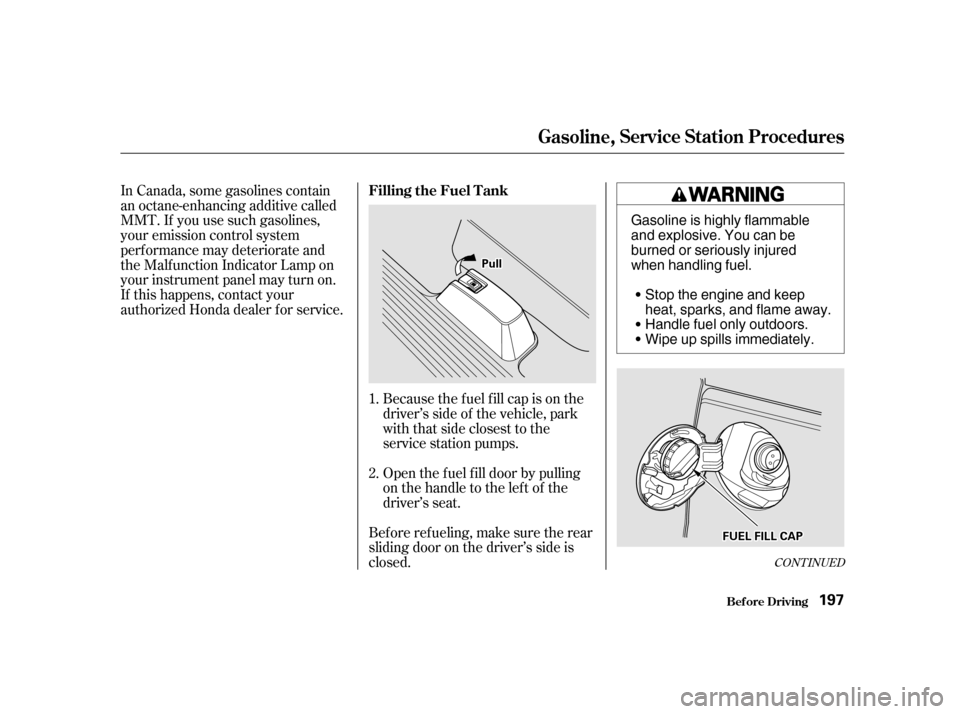2001 HONDA ODYSSEY octane
[x] Cancel search: octanePage 195 of 363

Help assure your vehicle’s f uture
reliability and perf ormance by paying
extra attention to how you drive
during the f irst 600 miles (1,000 km).
During this period:Avoid full-throttle starts and rapid
acceleration.
Avoidhardbraking.Newbrakes
need to be broken-in by moderate
use f or the f irst 200 miles (300
km). Your Honda is designed to operate
on unleaded gasoline with a pump
octane number of 86 or higher. Use
of a lower octane gasoline can cause
a persistent, heavy metallic rapping
noise in the engine that can lead to
mechanical damage.
Youshouldfollowthesesamere-
commendations with an overhauled
or exchanged engine, or when the
brakes are replaced.
We also recommend that you should
not tow a trailer during the f irst 500
miles (800 km).
We recommend gasolines containing
detergent additives that help prevent
f uel system and engine deposits.
Using gasoline containing lead will
damage your vehicle’s emissions
controls. This contributes to air
pollution.
Do not change the oil until the
recommended time or mileage
intervalshowninthemaintenance
schedule.
Break-in Period, Gasoline
Bef ore Driving
Break-in Period
Gasoline
196
Page 196 of 363

Because the f uel f ill cap is on the
driver’s side of the vehicle, park
with that side closest to the
service station pumps.
Open the f uel f ill door by pulling
onthehandletotheleftof the
driver’s seat.
In Canada, some gasolines contain
an octane-enhancing additive called
MMT. If you use such gasolines,
your emission control system
perf ormance may deteriorate and
the Malf unction Indicator Lamp on
your instrument panel may turn on.
If this happens, contact your
authorized Honda dealer f or service.
Bef ore ref ueling, make sure the rear
sliding door on the driver’s side is
closed.
1. 2.
CONT INUED
Bef ore Driving
Filling the Fuel Tank
Gasoline, Service Station Procedures
197
PPuullll
FFUUEELLFFIILLLLCCAAPP
Gasoline is highly flammable
and explosive. You can be
burned or seriously injured
when handling fuel.
Stop the engine and keep
heat, sparks, and flame away.
Handle fuel only outdoors.
Wipe up spills immediately.
Page 237 of 363

The Maintenance Schedule specif ies
how of ten you should have your
vehicle serviced and what things
need attention. It is essential that
you have your vehicle serviced as
scheduled to retain its high level of
saf ety, dependability, and emissions
control perf ormance.Service your vehicle according to the
time and mileage periods on one of
the Maintenance Schedules on the
f ollowing pages. Select the schedule
f or ‘‘Severe Conditions’’ if most of
your driving is done under one or
more of the conditions listed on that
page.Otherwise,followtheschedule
f or ‘‘Normal Conditions.’’
The services and time or distance
intervals shown in the maintenance
schedule assume you will use your
vehicle as normal transportation f or
passengers and their possessions.
You should also f ollow these
recommendations:
Avoid exceeding your vehicle’s
load limit. This puts excess stress
on the engine, brakes, and many
other parts of your vehicle. The
load limit is shown on the tire
inf ormation label on the driver’s
doorjamb. Operate your vehicle on
reasonable roads within the legal
speed limit.
Drive your vehicle regularly over a
distance of several miles
(kilometers).
Always use unleaded gasoline with
theproperoctanerating(seepage
).
196
Maintenance Schedule
Maint enance Which Schedule to Follow:
238
Page 337 of 363

Some conventional gasolines are
being blended with alcohol or an
ether compound. These gasolines
are collectively ref erred to as
oxygenated f uels. To meet clean air
standards, some areas of the United
States and Canada use oxygenated
f uels to help reduce emissions.
If you use an oxygenated f uel, be
sure it is unleaded and meets the
minimum octane rating requirement.
Bef ore using an oxygenated f uel, try
to conf irm the f uel’s contents. Some
states/provinces require this
informationtobepostedonthepump.The f ollowing are the U.S. EPA and
Canadian CGSB approved
percentages of oxygenates:
(Methyl Tertiary Butyl
Ether)
You may use gasoline containing up
to 15 percent MTBE by volume. (ethyl or grain alcohol)
You may use gasoline containing up
to 10 percent ethanol by volume.
Gasoline containing ethanol may be
marketed under the name ‘‘Gasohol.’’
(methyl or wood
alcohol)
Your vehicle was not designed to use
fuel that contains methanol.
Methanol can corrode metal parts in
the fuel system, and also damage
plastic and rubber components. This
damage would not be covered by
your warranties. If you notice any undesirable
operating symptoms, try another
service station or switch to another
brand of gasoline.
Fuel system damage or perf ormance
problems resulting f rom the use of
an oxygenated f uel containing more
than the percentages of oxygenates
given above are not covered under
warranty.
MT BE
ET HA NOL
MET HA NOL
T echnical Inf ormation
Oxygenated Fuels
338
Page 338 of 363

If you are planning to take your
Honda outside the U.S. or Canada,
contact the tourist bureaus in the
areas you will be traveling in to f ind
out about the availability of unleaded
gasoline with the proper octane
rating.
If unleaded gasoline is not available,
be aware that using leaded gasoline
in your Honda will af f ect perf or-
mance and fuel mileage, and damage
its emissions controls. It will no
longer comply with U.S. and
Canadian emissions regulations, and
will be illegal to operate in North
America. To bring your vehicle back
into compliance will require the re-
placement of several components,
such as the oxygen sensors and the
three way catalytic converter. These
replacements are not covered under
warranty.T echnical Inf ormation
Driving in Foreign Countries
339
Page 355 of 363

Fluids..................
Windshield Washer . 258
FM Stereo Radio
...........................
Reception . 162, 174
.................
Folding the Third Seat . 115
.....
Foreign Countries, Driving in . 339
..........................
Four-way Flashers . 75
.................................................
Fuel . 196
......................
Fill Door and Cap . 197
...........................................
Gauge . 67
................
Octane Requirement . 196
...............................
Oxygenated . 338
........................
Reserve Indicator . 65
........................
Tank, Filling the . 197
.....................
Fuses, Checking the . 324
...............
Gas Mileage, Improving . 202
..........................................
Gasohol . 338
.........................................
Gasoline . 196
...............
Fuel Reserve Indicator . 65
...........................................
Gauge . 67
................
Octane Requirement . 196
........................
Tank, Filling the . 197
................
Gas Station Procedures . 197 Gauges
...
Engine Coolant Temperature . 67
...............................................
Fuel . 67
...............................
Speedometer . 66
.................................
Tachometer . 66
GAWR (Gross Axle Weight
.......................................
Rating) . 228
GCWR (Gross Combined Weight .......................................
Rating) . 228
............
Gearshif t Lever Positions . 213
..............................
Glass Cleaning . 298
........................................
Glove Box . 91
GVWR (Gross Vehicle Weight
.......................................
Rating) . 228
.............
Halogen Headlight Bulbs . 282
..............
Hazard Warning Flashers . 75
........................................
Headlights . 70
........................................
Aiming . 282
..............
Automatic Lighting Off . 71
............
Daytime Running Lights . 71
..................
High Beam Indicator . 65
.........................
Reminder Chime . 70
........
Replacing Halogen Bulbs . 282 ...................................
Turning on . 70
............................
Head Restraints . 110
...............................
Heated Mirror . 122
.....................
Heating and Cooling . 136
.............
High Altitude, Starting at . 211
.................
High-Low Beam Switch . 70
HomeLink Universal
.................................
Transmitter . 99
....................................
Hood Latch . 264
.......................
Hood, Opening the . 198
..................................................
Horn . 69
.................................
Hydroplaning . 225
...
Identif ication Number, Vehicle . 332
Ignition
..............................................
Keys . 80
...........................................
Switch . 82
............
Timing Control System . 341
........................
Immobilizer System . 81
.........
Important Safety Precautions . 6
.........
Indicators, Instrument Panel . 61
..................
Individual Map Lights . 133
...............................
Inf ant Restraint . 32
Index
G H I
IV
Page 357 of 363

..............................
Paint Touch-up . 295
..............
Panel Brightness Control . 71
........................
Park Gear Position . 213
...........................................
Parking . 217
...............................
Parking Brake . 122 .................................
Parking Lights . 70
..
Parking Over Things that Burn . 217
.............................
PGM-FI System . 341
..................
Polishing and Waxing . 295
Power Sliding Doors
.................................
Indicator . 64, 98
.....................................
Operation . 94
.......................................
Switches . 94
............
Pre-Drive Saf ety Checklist . 11
.........
Pregnancy, Using Seat Belts . 20
............................
Protecting Adults . 12
...
Additional Safety Precautions . 20
.....
Advice f or Pregnant Women . 20
........................
Protecting Children . 22
.......................
Protecting Inf ants . 32
.......
Protecting Larger Children . 41
.........
Protecting Small Children . 37
Using Child Seats with
.....................................
Tethers . 45
.....................
Lower Anchorages . 47
...
Octane Requirement, Gasoline . 196
.........................................
Odometer . 66
...............................
Odometer, Trip . 67
Oil
........................
Change, How to . 251
......................
Change, When to . 240
......................
Checking Engine . 200
..............
Pressure Indicator . 62, 318
Selecting Proper Viscosity
......................................
Chart . 250
...........
ON (Ignition Key Position) . 83
..
Operation in Foreign Countries . 339
............................
Outside Mirrors . 121
....................
Overheating, Engine . 315
.......
Owner Maintenance Checks . 247
.........................
Oxygenated Fuels . 338
...................
Radiator Overheating . 315
.............
Radio/CD Sound System . 173
...........................
Readiness Codes . 321 ...............................
Rear A/C Unit . 158
.......................
Rear Compartment . 128
Rear Lights, Bulb
......................
Replacement . 284, 285
..........................
Rear View Mirror . 121
.................
Rear Window Def ogger . 75
...............................
Rear Windows . 120
.
Rear Window Wiper and Washer . 74
.....
Reclining the Seat Backs . 106, 109
.........
Reclining the Second Seats . 106
..............
Reclining the Third Seat . 106
.............................
Reminder Lights . 61
................
Remote Audio Controls . 191
.......................
Remote Transmitter . 85
Removing the Second
...........................................
Seats . 114
Replacement Inf ormation .................
Air Cleaner Element . 262
.......................................
Coolant . 255
................
Engine Oil and Filter . 251
..........................................
Fuses . 323
................................
Light Bulbs . 282
....................................
Schedule . 238
................................
Spark Plugs . 264
................................
Timing Belt . 273
...........................................
Tires . 277
Index
P
O
R
VI
Page 363 of 363

Service Inf ormat ion Summary
Gasoline:
Fuel Tank Capacity:Tire Pressure (measured cold):
Power Steering Fluid:
Brake Fluid:
Recommended Engine Oil:
Automatic Transmission Fluid: 35 psi (240 kPa , 2.4 kgf/cm
)
60 psi (420 kPa , 4.2 kgf/cm
)
Honda Power Steering Fluid
preferred, or another brand of
power steering fluid as a
temporary replacement. Do not
use ATF (see page ).
Honda Heavy Duty Brake Fluid
DOT 3 preferred, or a DOT 3 or
DOT 4 brake fluid as a temporary
replacement (see page ).
Unleaded gasoline, pump octane
number of 86 or higher.
Front/Rear:
Compact Spare Tire:
API Service SJ ‘‘Energy
Conserving’’ oil, SAE 5W-30
viscosity (see page ).
Oil change capacity (including
filter): 4.6 US qt (4.4
, 3.9 Imp qt)
Honda ATF-Z1 (Automatic
Transmission Fluid) preferred, or
aDEXRON
III ATF as a
temporary replacement (see page ). 249
261
260
259
20.00 US gal (75.7
, 16.65 Imp gal)